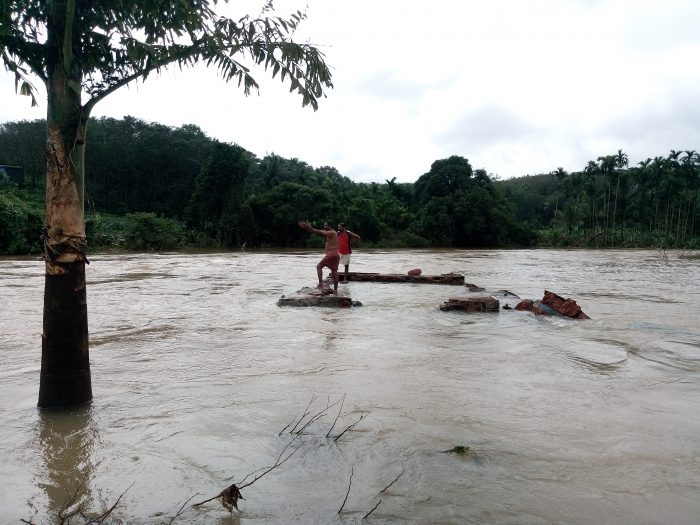
Last updated:
Kerala Floods

Overview
While the Indian state of Kerala regularly receives heavy monsoon rains, the 2018 monsoon rains in Kerala brought a record 93.6 inches (2,378 mm) of rain over 88 days.
While the Indian state of Kerala regularly receives heavy monsoon rains, the 2018 monsoon rains in Kerala brought a record 93.6 inches (2,378 mm) of rain over 88 days. The last time this volume of rain was recorded was in 1924 when 132.6 inches (3,368 mm) fell. Despite the fact that the 1924 rains fell in only 27 days, the 2018 floods were made much worse by illegal stone quarries, reduced green space and other human interventions.
Kerala sits on the eastern coast of the Arabian Sea and is home to steep geographical features along with coffee and tea plantations as well as other agricultural resources. As a result, there are dozens of dams along Kerala’s 44 rivers, 41 of which lead to the Arabian sea. While blame was initially placed on these dams for not opening soon enough, a study led by India’s Central Water Commission found that these dams were not responsible for the flooding because they were not designed for flood control, but for power generation and irrigation.
(Photo Source: Akbarali)
What is the impact on the communities?
The flooding and landslides affected 5.4 million people and killed more than 400. A reported 1,259 of 1,664 villages across the province were affected, and volunteer search and rescue teams composed primarily of fishermen are credited with saving 65,000 people. A government post-disaster assessment identified $3.8 billion in damages and loss, and a total recovery need of $4.4 billion – primarily in infrastructure needs. The same report also identified that more than 300,000 wells and 95,000 household latrines had been affected by the flooding. While there was no outbreak of infectious disease as a result of these floods, 332 health facilities were damaged or destroyed across the province.
Like much of India, Kerala Province experiences monsoons on an annual basis. As a result, there is a significant need for sustainable and durable housing and other infrastructure. While the monsoons can be helpful by providing moisture for agriculture, when they are stronger than expected they can cause billions of dollars in damage.
Sustainable and Resilient Housing
Over 18,000 homes required reconstruction after the 2018 floods in Kerala. Homes that are built to be sustainable and resilient towards extreme monsoon seasons will help ensure the resilience of people in the region.
Resilient Infrastructure
Water, Sanitation and Hygiene (WASH), transportation, power, and communications infrastructure that are built to withstand extreme monsoons can help communities receive support sooner and the efficient deployment of relief and recovery resources.
Agricultural Support
Billions of dollars of crops and livestock were destroyed by the 2018 floods. This resulted in not only significant economic loss but an increase in hunger and malnutrition. The use of crops that are resilient to flooding can help the region better absorb significant amounts of rain and stabilize the slopes in the area.
Contact CDP
Recovery updates
If you are a responding NGO or a donor, please send updates on how you are working on recovery to tanya.gulliver-garcia@disasterphilanthropy.org.
Donor recommendations
If you are a donor looking for recommendations on how to help in the recovery, please email regine.webster@disasterphilanthropy.org.
Philanthropic and government support
The Center for Disaster Philanthropy awarded three grants totaling just under $500,000 in support of recovery from the 2018 Kerala floods.
- Habitat for Humanity International was awarded $157,786 to support their Housing Support Service Centers. These centers assisted 3,000 families through housing support service assistants, 500 individuals for skills upgrading and the training of 100 unemployed youth in construction-related skills.
- Oxfam America received $236,741 for two projects. The first was to build back Water, Sanitation and Hygiene (WASH) systems and structures for 3,000 households across Kerala. The second was to secure disaster recovery and risk reduction through the augmentation of the livelihoods of women in flood-affected families.
- Plan International received $99,999 to support their SAKSHAM – Self-Employment for Young People program by increasing the number of women in targeted communities who are self-reliant and have recovered pre-disaster livelihood or source of income. The project accomplished this by providing vocational training to 400 youth and women.
Governments from across Europe sent approximately $2.2 million in relief funds to Kerala after the floods, most of which came from the Government of Italy and the European Union.
- The Bill and Melinda Gates Foundation gave $600,000 to the United States Fund for UNICEF to provide critical humanitarian support to flood-affected people.
- The Coca-Cola Foundation donated $500,000 to CARE India to support recovery from the floods.
- The Sheth Family Foundation donated $6,500 to Sewa International’s ASPIRE program to support flood relief.
- The Greater Houston Community Foundation made a $250 matching grant to the International Catholic Migration Commission for Kerala Flood Relief.
We welcome republication of our content. Please credit the Center for Disaster Philanthropy.
Fund resources

Monsoon Seasons
While often thought of as long-term heavy rain over a specific area, a monsoon is actually the name for a seasonal change in the direction of the prevailing winds. It can bring either extremely wet or extremely dry weather to an area.

Critical Infrastructure and Systems
Critical Infrastructure and Systems (CIS) are the structures people rely on to perform their everyday tasks. They are what keep people, goods and information moving around the world while also keeping people safe and healthy.

Electricity and Power Infrastructure and Systems
Electricity and Power Infrastructure and Systems are the combination of human and physical resources used to create, transmit, transform and distribute electrical power in places around the world.